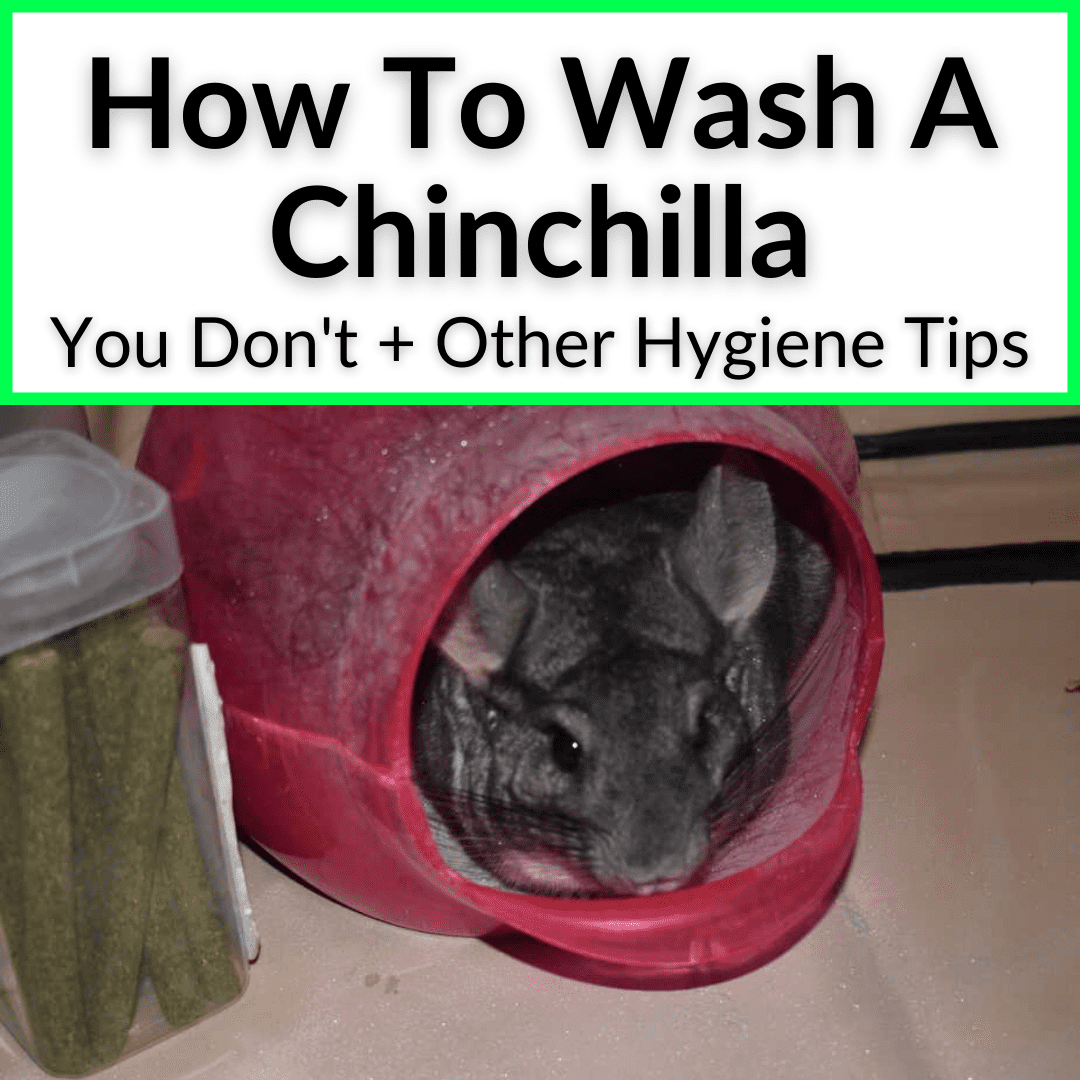
It seems there are two distinct narratives and they are completely opposite.
Some say chinchillas are clean animals and keeping them that way does not take a lot of work.
Other say it takes significant effort to keep these little rodents clean.
So which is true?
The first. It’s easy. You only need to stay on top of a few things to keep your chinchilla in good hygiene.
And one of those things is washing your chinchilla. But that is not at all what it sounds like. Let me explain.
Contents
How To Wash A Chinchilla
Washing a chinchilla is easy. Because you don’t.
That’s right, you never need to wash your chinchilla. In fact, you absolutely should never wash your chinchilla.
I know what you’re probably thinking. Are chinchillas really that clean?
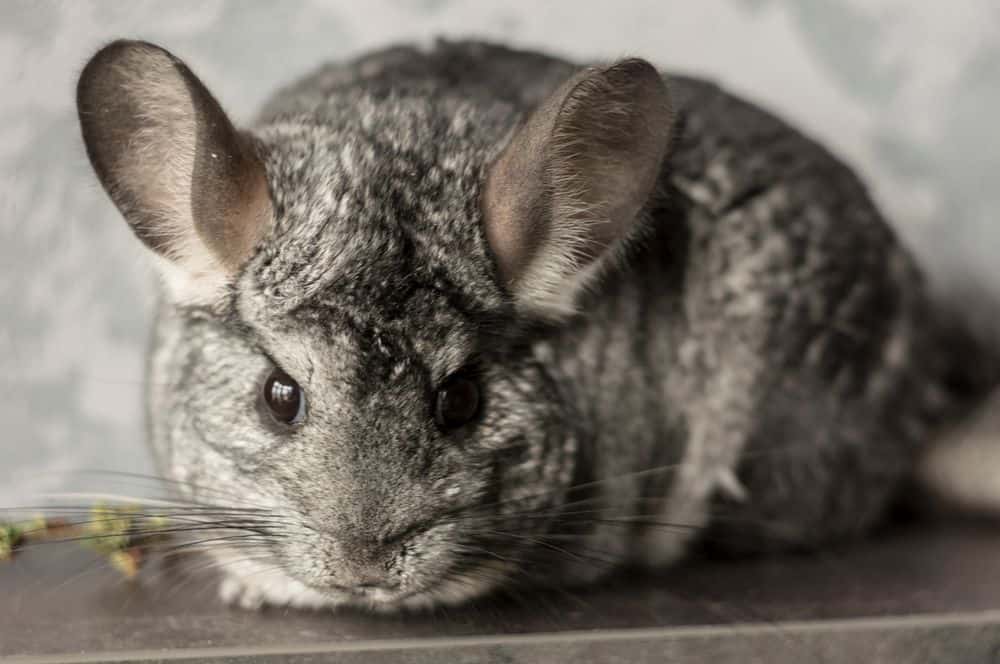
They are. Chinchillas are very clean animals. Heck, chinchillas don’t even smell under most circumstances.
Of course, exceptions apply but it’s hard to find another family pet you can adopt that rarely produces any odor.
Additionally, chinchillas have hard nuggets for poop that also have no odor. And you can take steps to ensure urine doesn’t become a smelly factor either.
So how do they do it? Dust. They bathe in dust.
And all you need t make those dust baths happen is a routine, the correctly formulated chinchilla dust, and a bowl to put it in. We will cover all of this shortly.
The rest of this post is will go into more details on chinchilla hygiene, with plenty of tips ad advice on making sure your chinchilla is always clean and healthy.
How to Keep Your Chinchilla Clean
Now we know how clean chinchillas are but how do we keep them so clean? Well, as mentioned, one big positive of owning a chinchilla is that it doesn’t get much easier to keep an animal clean.
And it all starts with the dust bath.
Of course, there are a few other factors you also need to stay on top of, like cage cleanings. We will cover the other important factors in this post as well.
But the most important piece of the puzzle is the establishing a dust bath routine. You can learn how to give a chinchilla a dust bath here. We will also cover the basics next.
Dust Baths To Wash A Chinchilla
A chinchilla dust bath is actually how these animals stay clean in the wild. Their dense fur can’t get wet (and it rarely rains in their natural habitat anyway), so they use dust to keep their fur healthy, silky, and not overly oily.
But it’s not just about staying clean. Chinchillas absolutely love rolling around in dust. It helps them relax and is a moment of pure joy. You can see how much fun Chili is having in her dust bath in this video.
The key to a good dust bath is buying the right dust. You need something that is specially formulated. A good dust bath house is a big plus, too.
Buy The Right Chinchilla Dust And A Good Bowl Or House
You need to get the right kind of dust to ensure it does not harm your chinchilla and that it actually works well to get it clean.
Luckily, it is easy to find good chinchilla dust. You can start with my article reviewing the best dust options for chinchillas.
But as long as you by a reputable brand on Amazon or good pet store, you should be fine. Just look for a label that says “chinchilla dust”.
It is typically a light grey sand-like substance and comes in a plastic container. It is specifically formulated to penetrate the fur and remove oil and dirt. And that is exactly what your chinchilla needs to remain healthy and clean.
Using cheap knock-off brands is usually not a good idea. Chances are it isn’t going to effectively work to clean your chinchilla’s fur and can eventually lead to overly oily fur and potential fungus infections and other illnesses. It could even be harmful.
To prepare a dust bath, you’ll need some kind of container to put the dust in. A dust bath house works best for this. I have an article that reviews and compares the best bath houses for chinchillas.
These houses are cheap, so it makes sense to just get one. But you can also just use a regular bowl in a pinch.
Whatever you use, you want to put a good amount of dust in the bottom. A small layer won’t give your chin enough to roll around in and get the job done effectively.
I always use 2 to 3 inches of dust in the dust bath house. Then I put it on the floor of the room that I chinchilla-proofed for playtime.
After that, all that’s left to do is open the door on the cage, allow your chinchilla out for playtime, and it will quickly find the dust bath house and roll around in it and have a blast.
You pet takes care of the rest of the work. Except for vacuuming and cleaning up the excess dust, of course. But that just takes a few minutes with a shop-vacuum and a Swiffer wet jet.
Up next on the to-do list is ensuring that you not only offer your chinchilla a dust bath but that you do so often enough.
Make Dust Baths A Frequent Routine
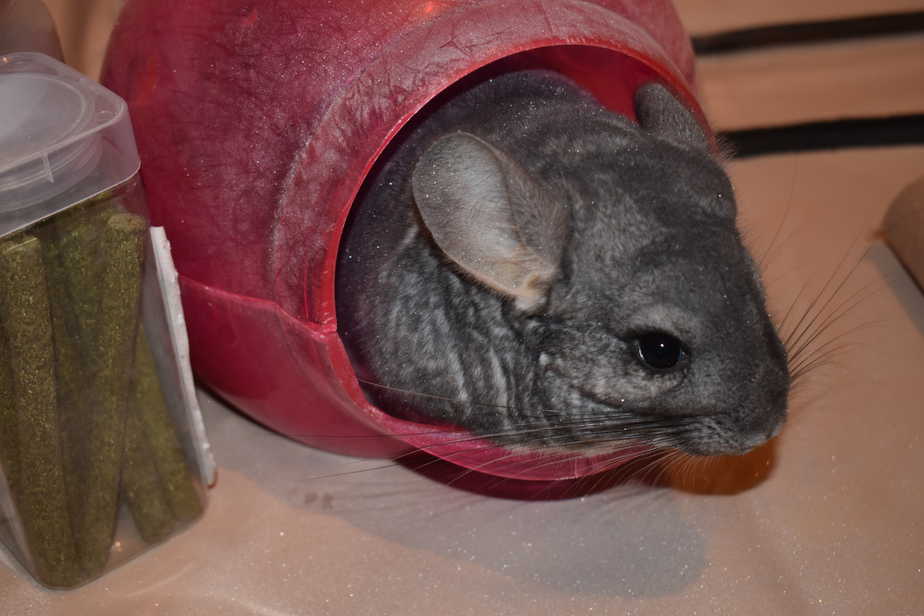
You should wash your chinchilla, i.e. give it a dust bath and let it clean itself, every 2 to 3 days. If you do not provide enough dust baths, it could lead to poor health, like various fur issues.
Luckily, giving a dust bath is easy and doing it 3 times a week is not asking much. If 10 to 15 minutes of your time a couple times a week is too much to ask, then you have a good indicator that perhaps you should not be a chinchilla owner.
I hate to be so blunt, but it’s the truth.
And have some more bad news for you. Unfortunately, giving dust baths is not the end of it. Your work isn’t quite complete.
You still need to do a few other small things to make sure your chinchilla’s hygiene stays at peak levels. No worries though. None of it is difficult or overly time consuming.
We’ll get to that in just a minute. First, let’s take a closer look at why you can’t just wash your chinchilla in water.
Why Chinchillas Can’t Bathe In Water
Under no circumstances can a chinchilla get wet. Never wash your chinchilla in water.
Avoiding water and using dust to bathe your chinchilla is critical to ensuring it remains healthy and never develops avoidable illnesses that could potentially lead to death.
Water can cause major issues to your chinchilla’s fur and health. As touched on above, this is because your chinchilla’s fur is much too dense to handle water.
Chinchilla have more than 80 hairs per follicle, which makes water a recipe for disaster. They are not be able to dry off sufficiently and can easily develop a respiratory infection or other illnesses, if they are exposed to water.
Now that we have thoroughly covered dust baths, the most important factor in keeping your chinchilla clean, let’s move on to the second most important factor.
Keeping Your Chinchilla’s Cage Clean
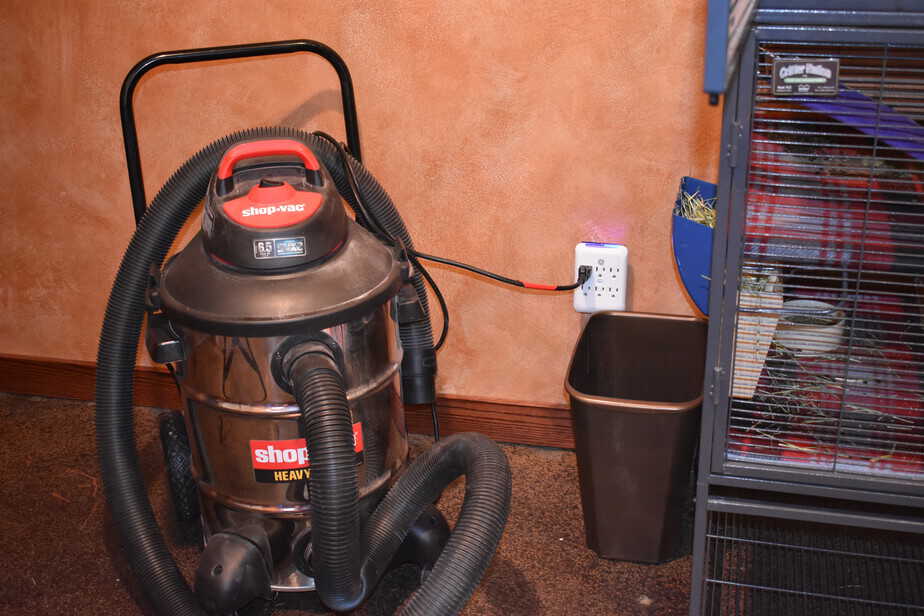
Here it comes. The cage cleaning process. I won’t go into too much depth on this topic, because I’ve already done that elsewhere.
You can get all of the information you need by reading my post detailing how often you need to clean a chinchilla cage.
The most important thing to mention is that cleaning the chinchilla cage is one of the most significant factors in keeping your chinchilla clean and healthy.
You need to regularly remove urine soaked bedding and you don’t want wood that’s been chewed into shavings sitting around the cage. Of course, you also want to remove all the poop nuggets around the cage.
I have some great tips on reducing mess in my post about keeping chinchilla poop inside the cage.
As for the cage cleaning, this is something you’re going to have to do quite often. There is no way around that.
But you can make things easier on yourself by using fleece liners as bedding. We’ll cover that in more detail below. First, let’s look at how often you should be cleaning the cage.
Cage Cleaning Frequency
It is important to understand that this is not a once a month type of thing. You absolutely need to clean the cage several times a week. I do a quick clean every single day.
Urine soaked fleece or bedding can cause damage to your chinchilla’s fur. Even worse, it can potentially cause fungal infections. Clearly, this is something you want to avoid at all at costs.
Luckily, all it takes is a routine. And the more you do it, the easier every future cage cleaning becomes, especially if you are well organized and plan of time.
For me, I shop-vacuum the poop out of the cage daily. I use fleece liners for bedding and I wash them once a week to ensure no urine or odor is present in the cage.
The reason I only need to do this once a week is that I have potty trained my chinchilla (more on this below). If yours does not use a litter pan, you’ll need to clean the fleece liners (or other bedding) far more often. Ideally, do it daily.
Poop And Pee Are The Biggest Hassles With Chinchillas
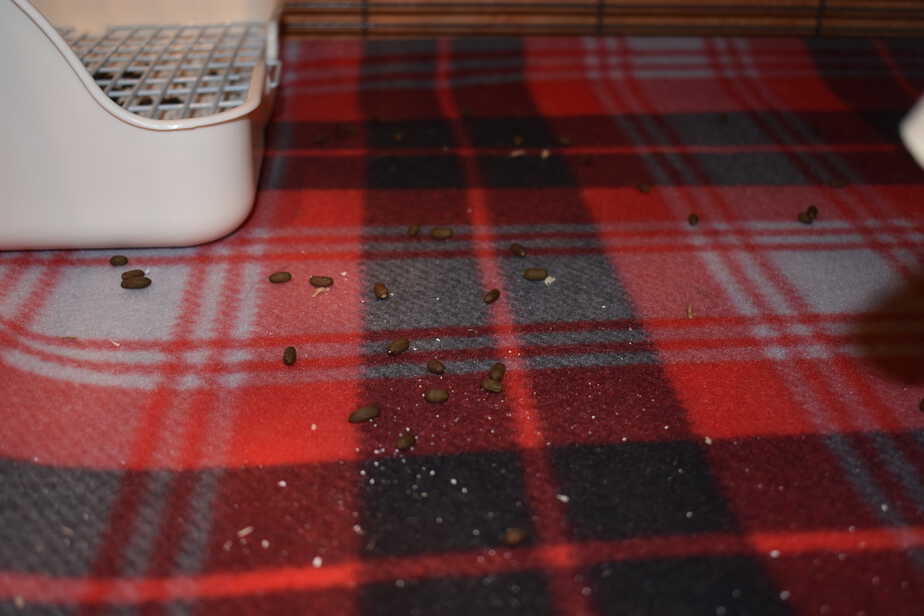
When I speak to other chinchilla owners, I hear by far the most complaints about pee and poop and keeping everything clean.
The unfortunate fact is that chinchilla poop happens all the time. So much so that I even dedicated an entire post to how often chinchillas poop.
But it isn’t anything to get to worked up over.
Again, chinchilla poop is very easy to clean and a broom and dustpan, or better yet a shop vacuum, are all you need to keep the cage clean daily.
I always keep the shop vacuum right next to my chinchilla’s cage. I turn it on, take care of business, and then I’m done for the day until my weekly larger cage cleaning.
It’s that easy and nothing to worry about.
Additionally, the urine issue is greatly reduced using my fleece liner trick, which we will cover next. And you can reduce it even more if you use my other trick, which is potty-training your chinchilla. We’ll cover that right after the fleece.
Fleece Liners Make Life Easier And Save Money
Fleece liners are one of the newer additions to my cage. They have been a huge benefit.
I never have to purchase bedding anymore and the fleece is better on my chin’s little feet. It also helps greatly in keeping the smell to a minimum.
Unfortunately, unless you know how to make your own fleece liners, you may run into issues finding the best liners for your cage trays. They are currently only designed for a limited number of different cage models.
Luckily one of them is my favorite cage and the one I use. It is the Critter Nation 2 cage and you can read my review here. That review also has a link to the fleece liners made specifically for the cage.
If you are a bit leery about the safety of fleece for your chinchilla, read my post examining if fleece liners are safe for chinchillas. It should help to put your mind at ease.
Fleece liners are easy to wash with cold water whenever they get soaked in urine. Then you air dry them (they dry quickly) and put them back in the cage. I usually do it while my chin is out for playtime. But you can also just get a second pair, quickly swap them out, and then wash the soiled ones in peace.
If you potty train your chinchilla, you minimize how often you have to wash the liners. I only do it once a week now.
Potty Training Makes Cleanings Even Easier
This is taking your chinchilla’s hygiene to the next level and really turning up the ability for your chinchilla to be at peak cleanliness.
But it isn’t the easiest task to complete. You must be willing to put some time into the process. First of all, you need to purchase a cage that can support this and that has adequate space.
That’s because yo need space in the cage for the litter training pan. You will obviously need to buy one of those pans, plus the critter litter to go in it.
I have a full post breaking down how to potty a train a chinchilla, if that’s something you are interested in doing.
Additional Cage Cleaning Tips
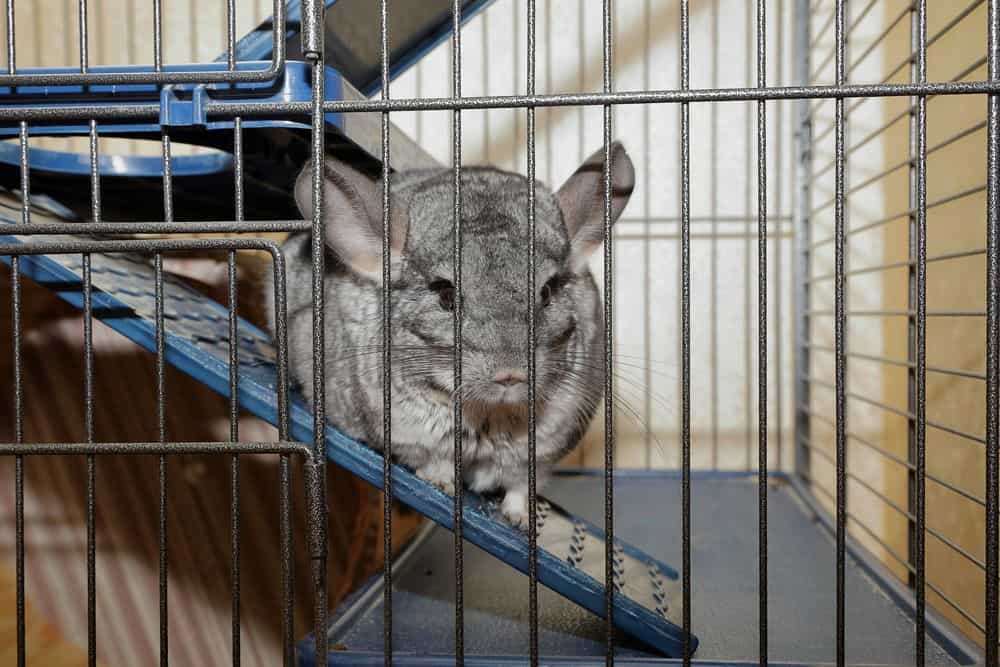
In addition to the tips we have already discussed, you can do a few other things to keep the cage as clean as possible. Here are three more tips to help keep the cage cleaner.
- Never place the dust bowl and dust bath inside the cage (this is an outside-the-cage activity)
- Remove chewed wood items such as chew sticks and hanging toys daily
- Wipe down shelves and hiding boxes weekly with a vinegar/water mix
How To Clean Urine Off A Chinchilla
Cleaning urine off a chinchilla is much more of a hassle than cleaning the cage, since you can’t get your chinchilla wet. So how do you do it?
The firs thing to know is that it is much easier to clean a urine stain from a chinchillas fur if you catch it early. So it is a god idea to always keep an eye out for urine stains on your pet, so you can jump in before the get much more difficult to clean.
If the stain is fresh and not too large, start with a dust bath. It will not get rid of all of it, but it will at least soak up some fresh urine and keep the stain from getting larger.
If you use only dust baths, it will probably take a a number of them to get rid of a urine stain. But you can help the process along.
You ca wipe down the stain with something like a damp washcloth or a baby wipe (unscented, of course). These are things that have enough moisture to clean the stain, but not enough to leave your pet’s fur soaked.
Of course, your chinchilla will not like this very much, so you might have a hard time holding it still. You also want to make sure you don’t apply too much pressure and hurt your poor little urine-soaked pet.
If none of this works and the stain is simply too large or too embedded, you will have no other option but to wash your chinchilla. I know I spent an entire article telling you not to do this, but in this case, you have no other option.
But you have to make sure you do it right, to minimize any danger to your pet.
Washing is the easy part, but that is relative. It still won’t be easy, because your chin is likely to struggle. Make sure you use a mild soap with no scenting to lather your pet after getting it wet. Then rinse out the soap.
Now comes the hard part: drying your chinchilla. You can use a towel to dry it off, but it will take a long time and your pet will be miserable. That, in turn, will make you pretty miserable too.
A blow dryer is also an option. But make sure to use the cool setting. A hot setting could overheat your chin.
Clean Chinchillas Are Great For Allergy-Prone Pet Owners
I absolutely love this about owning a chinchilla. Chinchillas are extremely allergy-friendly. They don’t produce dander and they also barely shed in any fashion.
Yes, chinchillas do shed slightly. But compared to any other animal with fur, it’s minimal. Additionally, due to their dense fur, you don’t have to worry about your chinchilla getting fleas.
Chinchilla owners report that the only issues that they encounter when it comes to allergies are the dust a chinchilla uses to bathe in. It can sometimes trigger allergies in some people. But for the most part, this shouldn’t be a significant concern.
Chinchilla Hygiene: Final Thoughts
If I haven’t made it clear by this point in this post, I want to do so now. Chinchillas are easy to keep clean and it doesn’t require much.
This post may have made you think the opposite, but once you adopt a chinchilla, you will realize what I’m talking about. It’s extremely straightforward and easy to get the job done.
At the end of the day, chinchillas are clean animals mostly by themselves. They self-groom and do a good job retaining the soft and friendly pet we all have grown to love.
However, keeping up with the tips we laid out in this post will help your chinchilla remain clean and healthy. After a few short weeks of implementing everything, you will become an expert on the topic as well.
When that happens, be sure to share your stories and additional concerns by dropping a comment below.
If you feel I have left out anything important about your chinchilla’s hygiene or ability to remain clean, be sure to drop a comment below as well.
If not, as always, Chili and I appreciate you stopping by and reading. We will catch you next time.
Leave a Reply